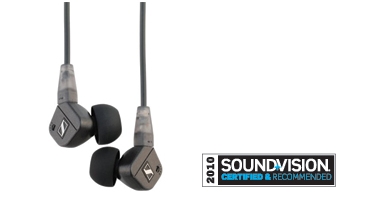In-Ear Headphones Face Off Page 3

Key Features |
| $450 Sennheiser.com |
| • Accessories: 10 pair ear tips, 2 ear hooks, cable clip, bass adjustment/cleaning tool, black plastic/brushed metal carry case, dry salt pad • Impedance/Sensitivity: 16 ohms/125 dB/mW |
Sennheiser IE8
The IE8 is Sennheiser's top in-ear headphone, and at $450, it's the most expensive in our test. Both it and the Monster Turbine Pro are distinct in this group for using a full-range dynamic driver rather than an armature transducer. The IE8 also lets you customize its bass output - a feature it shares with the Sleek Audio SA6. The IE8's compact, diamond-shaped earpieces each have a tiny 5-position rotary trim control for this purpose that is adjusted with a supplied tool. Sennheiser's accessory kit contains no adapters, but you get ear hooks, a cable clip, and a slick slide-out storage case.
PERFORMANCE
Running the test tones helped me quickly determine that the default low setting for the Sennheiser's bass control appeared to roll off frequencies below 40 Hz, which would have left an extremely lean tonal balance. Cranking up the control to its max restored noticeable energy to the 30- to 40-Hz band, and also gave me a little juice in the 25- to 30-Hz range that wasn't there before. Below that, some output was detectable, but it was too far down in level to be useful. The full-range sweep also suggested a very slight dip in upper-midrange response, but the curve was otherwise smooth to a point beyond 15 kHz.
Once adjusted, the IE8 proved itself a superlative all-around performer. It handled all the challenges of the Sound Check instrument tracks with aplomb. The piano notes were full-bodied and reproduced with good transient details on the leading hammer strike, and the male vocal was appropriately weighty and highly dynamic, with no apparent stress in the peaks. The flute and sax reproduced very naturally as well, with great tonal purity on the flute and the expected reedy texture for the sax, and with none of the mild stridency on dynamic peaks that some of the other 'phones imparted.
I was equally impressed with how the IE8 handled the songs in my test suite. "Wishing Well," my jazz track, displayed a decent bass line, and Michael Ruff's voice came across as highly detailed, with a very natural presentation. Furthermore, the IE8 was among the most open-sounding when I played the Stravinsky track. It delivered massed strings with stunning sweetness, and the triangle had a clarity and dimensionality that made it stand out from the crowd. The IE8's sound also held together with no strain, even on the loud, complex passages and the final timpani bangs. The Sennheiser's primary weakness was that it was missing that last little bit of bass that would have lent more impact to R&B tracks like "I Can't Stand the Pain" and the African drums.
BOTTOM LINE
Hip-hop fans might yearn for more bottom end, but the IE8's accurate and refined midrange and highs, solid dynamic capabilities, and effective soundstage presentation place it among the top three in this test. A great choice for classical music fans.























































